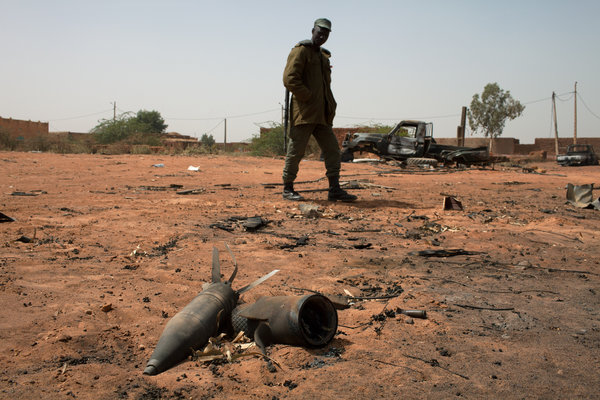
From C.J. Chivers, New York Times: Since the war that toppled Col. Muammar el-Qaddafi began in 2011, arms-tracking analysts have warned that weapons looted from the colonel’s stockpiles could find their way to militants in sub-Saharan Africa.
Although public evidence for transfers has been scarce or not fully verifiable, persistent accounts of smuggled arms reaching Mali have circulated for more than a year, just as reports have repeatedly suggested that weapons formerly in Libya were turning up in Egypt, Gaza, Chad, Lebanon, Syria and elsewhere.
In the case of Mali, the reports appeared alongside signs of the growing strength of jihadists in the country’s north. The timing, researchers said, suggested that weapons from Libya had changed the course of Mali’s war — so much so that the French military eventually intervened.
Recent photographs from Mali provide perhaps the clearest publicly available indication yet that these transfers have in fact occurred.
The first photograph, filed on Jan. 26 by Reuters, shows a slightly damaged finned projectile resting on the dirt in Konna, the city in central Mali from which a French-led military attack expelled militants last month. A New York Times photographer later documented more examples of the same weapons.
The projectiles in question were NR-160s, antitank munitions manufactured by a now-defunct company in Belgium that in the 1970s and 1980s extensively sold arms to Colonel Qaddafi’s military. Fired through American-designed recoilless rifles that have a history in Libya since early in the cold war, the projectiles were identical to ordnance documented in Libya in 2011.
They had been left behind in Konna by Islamists who had been pounded by an aerial attack, and suffered many losses.
Many other types of weapons that could have come from Libya have been present in the fighting in Mali, including Soviet-era assault rifles, machine guns and rocket-propelled grenades. Unlike these items, the NR-160 was not a widely distributed or globally produced export product that could have come from myriad sources. It was a peculiar item with a limited circulation and a well-established tie to Libya.
When combined with images of other weapons strongly associated with Libya that have also turned up in Mali, the presence of NR-160s suggests that evidence is hardening that weapons cast loose in Libya are contributing to instability elsewhere, perhaps most vividly in Mali.
It also offers insight into arms deals that have gone awry, and foreign policy choices that had costly, unintended effects. . . .
This presumed influx of weapons to Mali from Libya has in turn underscored the unwanted effects of a war supported by the West, and raised questions anew about why NATO and the allied militaries that helped defeat the Qaddafi military did little to contain weapons that foreign military intervention helped set loose. (photo: Tyler Hicks/New York Times)
Image: nyt%202%208%2013%20Libyan%20arms%20in%20Mali.jpg
